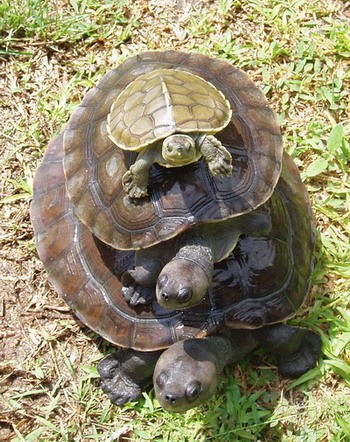By Ana Verayo, | February 04, 2016

Turtles and tortoises were roasted by early Paleolithic humans and were eaten as snacks.
The humble tortoise is apparently a favorite prehistoric snack by ravenous early humans as revealed by a new study. Early humans thriving during the Lower Paleolithic Period some 2.5 million to 200,000 years ago, learned how to cook and consume tortoises and turtles in numerous cooking methods.
Like Us on Facebook
Researchers from Tel Aviv University in Israel discovered telltale evidence of turtle remnants from the Qesem Cave, which is considered as an important archaeological site near Tel Aviv. Findings reveal that early humans are fond of eating turtles including large game and plants. This new study also supplements the wide diet range of early Paleolithic people along with their tool skills.
It has also been widely believed that Paleolithic humans only hunted large game and are limited to vegetal material, says author of the study, Ran Barkai, who is an archaeologist of Tel Aviv University. This new discovery now adds an interesting dimension to early humans' culinary skills, giving them more cultural depth.
Tortoise remains are found scattered all over the cave in various amounts, where the team suggests that they were eaten over the whole span of early humans, which is about 200,000 years old. When the bones were excavated, the bones revealed marks that are signs of how early humans prepared and have eaten the ancient turtles.
Barkai says that dental evidence was discovered earlier from prehistoric inhabitants of the Qesem Cave that they have also eaten vegetal food. In this new study, early humans are confirmed to have feasted upon tortoises that have been butchered and roasted even if there have only little calories in them, compared to deer.
Researchers also added that the marks also show that majority of the turtles were roasted in their shells and in some cases, the shells were cracked open and butchered them with flint tools, where humans clearly utilized fire to roast and cook the turtles. Apart from this, large game are also part of the early human diet especially for the cave inhabitants.
According to study author, archaeologist Ruth Blasco from the Centro Nacional de Investigacion Sobre la Evolucion Humana in Spain, slow moving animals were also considered as preserved or "canned food" for early humans, as they need to maximize all their resources where this even adds a new dimension in their culture, providing clues how early humans developed taste preferences.
This new new study is published in the journal, Quaternary Science Reviews.
-
Use of Coronavirus Pandemic Drones Raises Privacy Concerns: Drones Spread Fear, Local Officials Say

-
Coronavirus Hampers The Delivery Of Lockheed Martin F-35 Stealth Fighters For 2020

-
Instagram Speeds Up Plans to Add Account Memorialization Feature Due to COVID-19 Deaths

-
NASA: Perseverance Plans to Bring 'Mars Rock' to Earth in 2031

-
600 Dead And 3,000 In The Hospital as Iranians Believed Drinking High-Concentrations of Alcohol Can Cure The Coronavirus

-
600 Dead And 3,000 In The Hospital as Iranians Believed Drinking High-Concentrations of Alcohol Can Cure The Coronavirus

-
COVID-19: Doctors, Nurses Use Virtual Reality to Learn New Skills in Treating Coronavirus Patients







